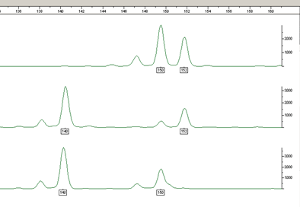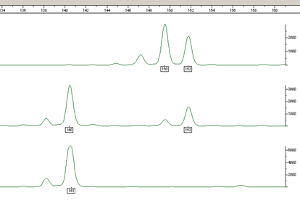Introduzione
Nei gatti esistono diversi tipi di gruppi sanguigni, tra i quali il sistema AB è il più importante. In questo sistema, i gatti possono avere il tipo A, B o AB.
La presenza di alte quantità di anticorpi anti-A naturalmente presenti nei gatti di tipo B porta all’esplosione dei globuli rossi di tipo A quando entrano in contatto con il sangue di tipo B. Questo avviene ad esempio nella isoeritrolisi neonatale (NI). La NI può verificarsi quando una fattrice di tipo B si accoppia con un maschio di tipo A e dà alla luce gattini di tipo A. Durante i primi giorni di vita, i gattini assorbono gli anticorpi anti-tipo A prodotti dalla fattrice di tipo B. Ciò provoca l’esplosione dei globuli rossi di tipo A del gattino, causando anemia, che può essere letale. È quindi importante per gli allevatori testare il tipo di sangue delle fattrici di riproduzione per identificare il rischio di NI e ridurre al minimo le possibilità di mortalità neonatale.
I test genetici K793 e K300
Il test genetico K793, disponibile per tutte le razze*, identifica due tipi di alleli recessivi b che sono associati al Gruppo Sanguigno B. Analizzando insieme queste due mutazioni, è possibile predire il gruppo sanguigno B nei gatti. Poiché devono ancora essere identificate ulteriori mutazioni, esiste la possibilità che i risultati genetici di questo test non corrispondano ai risultati convenzionali della tipizzazione sanguigna (sierologia).
Il test genetico K300, disponibile per i Ragdoll, identifica una variante dell’allele AB ed è associato al Gruppo Sanguigno AB nei gatti Ragdoll. Poiché i gatti di tipo AB di altre razze non hanno la variante di tipo AB dei Ragdoll che viene analizzata con il test genetico K300, deve essere presente almeno un’altra variante che comporti anche Gruppo Sanguigno AB in altre razze di gatti. Questa variante deve ancora essere identificata.
Test sierologico K712
Un altro metodo per identificare i tipi di sangue dei gatti è la sierologia. Questo metodo non fornisce informazioni sulla genetica in modo diretto e quindi non è adatto per essere utilizzato come unico metodo nella scelta degli accoppiamenti. Quando i test genetici (K300 e/o K793) forniscono un risultato inconcludente (tipo A o AB), il test sierologico può essere utilizzato per distinguere tra sangue di tipo A o tipo AB.
La tipizzazione sanguigna sierologica viene utilizzata principalmente per le trasfusioni di sangue e può essere eseguita solo su sangue intero (EDTA o eparina).
Interpretazione dei risultati
I gatti con due copie di uno qualsiasi dei due alleli b hanno il Gruppo Sanguigno B. I gatti con una copia di uno qualsiasi dei due alleli b e quindi portatori di b, possono avere il gruppo sanguigno A o AB, a seconda del secondo allele presente.
I Ragdoll con due copie dell’allele AB hanno il sangue di tipo AB. I Ragdoll con una copia dell’allele AB e quindi portatori di AB possono avere il sangue di tipo A o AB, a seconda del secondo allele presente.
Si prega di notare che non è possibile distinguere tra il tipo A o AB con i nostri test genetici quando viene eseguito solo il test K300 (solo per i Ragdoll) o il test K793. Per fare una distinzione tra il sangue di tipo A o AB, si può utilizzare il test sierologico K712. Per i Ragdoll, per ottenere il risultato più accurato, si consiglia di eseguire sia il test K300 che il test K793.
Gruppo Sanguigno (tutte le razze *) – K793
| Risultato Genetico | Genotipo | Interpretazione |
|---|---|---|
| Nessun allele b | N/N | Il gatto ha Gruppo sanguigno A or AB ** |
| Una copia di allele b | N/b | Il gatto ha Gruppo sanguigno A or AB ** |
| Due copie di allele b | b/b | Il gatto ha Gruppo sanguigno B |
| Inconcludente | – | Non è possibile determinare il gruppo sanguigno, il gatto ha il sangue di tipo A, B o AB. Il test sierologico K712 può fornire informazioni aggiuntive. |
Gruppo Sanguigno (Ragdoll) – K300
| Risultato Genetico | Genotipo | Interpretazione |
|---|---|---|
| Nessun allele AB | N/N | Il gatto ha Gruppo sanguigno A or B *** |
| Una copia dell’allele AB | N/AB | Il gatto ha Gruppo sanguigno A or AB *** |
| Due copie dell’allele AB | AB/AB | Il gatto ha Gruppo sanguigno AB |
Gruppo Sanguigno (Ragdoll) – K300 e K793 combinati
| Risulato K300 | Risultato K793 | Interpretazione |
|---|---|---|
| N/N | N/N | Il gatto ha Gruppo sanguigno A |
| N/AB | N/N | Il gatto ha Gruppo sanguigno A |
| AB/AB | N/N | Il gatto ha Gruppo sanguigno A |
| N/N | N/b | Il gatto ha Gruppo sanguigno A |
| N/AB | N/b | Il gatto ha Gruppo sanguigno AB |
| N/N | b/b | Il gatto ha Gruppo sanguigno B |
*Alcune razze come Siamesi, Burmesi e Orientali a pelo corto non hanno l’allele b
** Si prega di notare che non è possibile distinguere tra il sangue di tipo A o AB con i nostri test genetici. Per fare una distinzione tra il sangue di tipo A o AB, si può utilizzare il test sierologico K712 per fornire informazioni aggiuntive.
*** Si prega di notare che non è possibile distinguere tra il sangue di tipo A o B solo con il test genetico K300 nei Ragdoll, il test genetico K793 può essere utilizzato per fornire informazioni aggiuntive.

